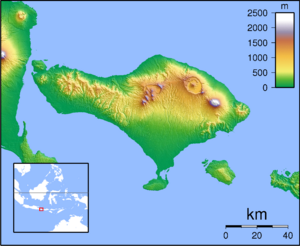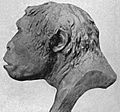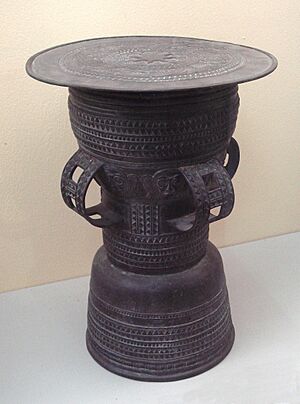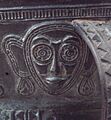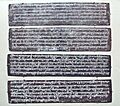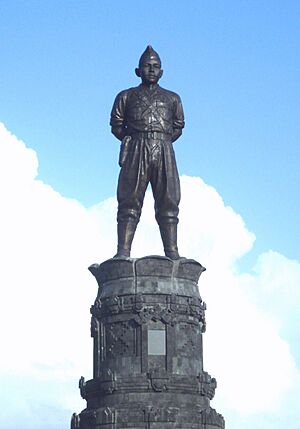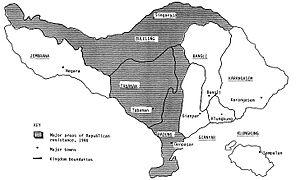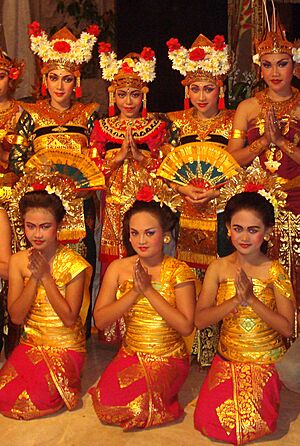History of Bali facts for kids
Bali is a beautiful island in Indonesia with a long and interesting history. People and cultures have moved to Bali from other parts of Asia for thousands of years. In the 1500s, Europeans started to arrive, which changed Bali's history. After a long time under Dutch rule, Bali became known for keeping its traditional culture alive and is now a very popular place for tourists to visit.
Contents
- How Bali Was Formed: A Volcanic Story
- Early Humans: Stone Age Life in Bali
- Neolithic Farmers: New People and Rice Growing
- Bronze Age: Metal Tools Arrive
- Ancient Kingdoms: Indian Influences (800-1343 CE)
- Middle History: Majapahit Rule and European Arrivals (1343–1846)
- Modern History: Dutch Control and Independence (1846–Present)
How Bali Was Formed: A Volcanic Story
The island of Bali, like many islands in Indonesia, was formed by huge movements of the Earth's plates. This is called tectonic subduction. One plate, the Indo-Australian plate, slides under another, the Eurasian plate. This process pushed up the old ocean floor, which was made of ancient sea deposits and coral reefs. You can still see these lifted Tertiary limestone layers in places like the Bukit peninsula, with its huge cliffs at Uluwatu.
These plate movements also caused cracks in the Earth's crust, leading to volcanoes. A line of volcanoes runs across the northern part of Bali. The oldest volcanoes are in the west, and the newest are in the east. The tallest is the active volcano, Mount Agung, which is 3,142 meters (10,308 feet) high.
Volcanoes have been very active over time. Most of Bali's surface is covered by volcanic rock and ash. This volcanic activity makes the soil very rich and fertile. This is a big reason why farming has always been successful on the island.
Bali is also located near the Sunda shelf, which means it was once connected to the nearby island of Java. This happened during the ice ages when sea levels were lower. Because of this connection, Bali's plants and animals are similar to those found in Asia.
Early Humans: Stone Age Life in Bali
Bali was connected to Java many times in the past. Even today, only a small strait, about 2.4 kilometers wide, separates the two islands.
Scientists found evidence of early humans in Java, called the Java man. These findings are between 1.7 and 0.7 million years old. They are some of the first known examples of Homo erectus.
Bali also had people living there in the Paleolithic (Old Stone Age) period. This was from about 1 million BCE to 200,000 BCE. Tools like hand axes have been found in villages such as Sembiran and Trunyan in Bali.
A Mesolithic (Middle Stone Age) period has also been identified, from 200,000 to 30,000 BCE. During this time, Homo erectus became better at gathering food and hunting. They used more advanced tools, like arrow points and tools made from animal bones. These early humans lived in temporary caves, like those found in the Pecatu hills. Around 45,000 BCE, the first Homo sapiens arrived. These were Australoid people who moved south and replaced Homo erectus.
-
Java man reconstitution.
-
Mesolithic arrow point, Bali Museum
Neolithic Farmers: New People and Rice Growing
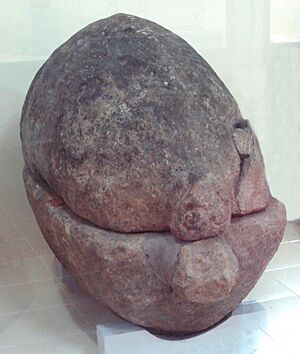
From about 3000 to 600 BCE, a new culture appeared in Bali. This was the Neolithic (New Stone Age) period. New groups of people arrived, bringing with them the skill of growing rice. They also spoke Austronesian languages. These Austronesian peoples likely came from South China, traveling through the Philippines and Sulawesi. They used tools like rectangular adzes and made pottery decorated with red slips.
These new people cleared forests to create farms and villages. They also made woven crafts, and a small boat was found from this time. They ate pork and chewed betel nuts. They are thought to have worshipped mountains. They buried important people in oval stone sarcophagi, which are like stone coffins. These sarcophagi sometimes had human heads or animal figures carved on them.
An important Neolithic site in Bali is Cekik, in the western part of the island. These Austronesian people continued to spread eastward, settling on islands in Melanesia and Polynesia around 2000 years ago. Many parts of Bali's culture today still show influences from this period. This connects Bali to the cultures of Southeast Asia and the Pacific Ocean.
Bronze Age: Metal Tools Arrive
The Bronze Age in Bali lasted from about 600 BCE to 800 CE. Between the 8th and 3rd centuries BCE, Bali learned about "Dong Son" metalworking techniques. These skills came from Northern Vietnam. These techniques allowed people to make complex metal items using molds, often with spiral or human-like designs. Since mold pieces were found in Bali, it's believed these items were made on the island. However, the materials for bronze, copper and tin, had to be brought in from elsewhere.
Many bronze tools and weapons were made, including axes, cooking tools, and jewelry. Large ceremonial drums from this time have also been found. One famous example is the "Moon of Pejeng," which is the largest ceremonial drum found in Southeast Asia. It dates back to around 300 BCE.
Stone sarcophagi were still used during this period, and bronze items have been found inside them.
Ancient Kingdoms: Indian Influences (800-1343 CE)

This period begins with the first written records in Bali. These are small clay tablets with Buddhist writings, found inside tiny clay stupa figurines. These "stupikas" are the earliest known writings in Bali and are from around the 8th century CE. They were found in the Gianyar area.
This time is strongly linked to the arrival and spread of Buddhism and Hinduism in Bali. The Belanjong pillar in southern Sanur has an inscription from 914 CE. It mentions the rule of the Balinese king Sri Kesari. The inscription is in both the Indian Sanskrit language and Old Balinese language. It uses two different writing styles.
The stone temple of Goa Gajah was built around the same time. It shows a mix of Buddhist and Hindu (Shivaite) art.
There were also marriages between royal families from Java and Bali. For example, King Udayana Warmadewa of Bali married a Javanese princess. Their son, Airlangga, became a powerful ruler in East Java and ruled both Java and Bali. Later, in the 12th century, some of Airlangga's descendants also ruled Bali.
The island of Java began to have a stronger influence on Bali when the Singhasari king Kertanegara invaded in 1284.
Bali also had important connections with China during this time. Chinese coins, called Kepeng, were used in Bali from the 7th century. The traditional Barong dance character might even come from Chinese pictures of lions. Some Balinese stories say that the 12th-century king Jayapangus of Bali married a Chinese princess.
-
Buddhist model clay stupa ("Stupika") inside which can be found clay tablets with Buddhist texts and Buddhist images. 8th century Bali.
Middle History: Majapahit Rule and European Arrivals (1343–1846)
Majapahit Influence
The Majapahit Empire from Java took full control of Bali when their Prime Minister, Gajah Mada, defeated the Balinese king in 1343. The Majapahit set up their capital in Bali first at Samprangan and then at Gelgel. Gelgel remained the most important kingdom in Bali until the late 1600s.
Majapahit rule brought a strong influence of Javanese culture to Bali. This included changes in architecture, dance, theater, literature (with the Kawi script), painting, sculpture, and the wayang puppet theater. A few Balinese people who did not adopt this new culture are still known today as "Bali Aga" (meaning "Original Balinese"). They live in a few isolated villages.
As Islam grew in Indonesia, the Majapahit empire eventually weakened. Bali became independent again in the late 1400s or early 1500s. Some stories say that Javanese nobles fled to Bali, bringing even more Hindu art, literature, and religion. Later records suggest that the Majapahit-linked dynasty continued to rule Bali for 500 more years until 1908. That's when the Dutch took over. In the 1500s, the Balinese king Dalem Baturenggong even expanded his rule to parts of East Java, Lombok, and western Sumbawa.
Around 1540, a Hindu religious change happened, led by Dang Hyang Nirartha. This led to the creation of the Padmasana shrine, which honors the "Supreme God" Acintya. It also shaped the way Shiva is worshipped in Bali today. Nirartha also built many temples, including the famous one at Uluwatu.
-
Pura Maospahit ("Majapahit Temple") was established during the period of the Majapahit Empire.
European Explorers Arrive
The first reports of Bali by Europeans might have come from travelers like Marco Polo in the past.
The first known direct contact by Europeans with Bali was likely in 1512. A Portuguese group led by António de Abreu and Francisco Serrão reached Bali's northern coast. Bali was also mapped in 1512 by Francisco Rodrigues. The Magellan expedition (1519–1522) might have seen the island too. Early Portuguese and Spanish maps called the island by names like Boly or Bale. Sir Francis Drake also briefly visited Bali in 1580.
In 1585, the Portuguese government in Malacca sent a ship to set up a fort and a trading post in Bali. But the ship crashed near the Bukit peninsula. Only five people survived and went to serve the king of Gelgel, known as the Dalem. They were given wives and homes.
In 1597, the Dutch explorer Cornelis de Houtman arrived in Bali with 89 men. He visited Kuta and Jembrana, then gathered his ships at Padang Bai. He was so excited that he named the island "Young Holland." They met the Dalem, who introduced them to one of the Portuguese survivors who had been serving him since 1585.
A second Dutch group arrived in 1601, led by Jacob van Heemskerck. The Dalem of Gelgel sent a letter to Prince Maurits of Holland. This letter was later used by the Dutch to claim rights to the island.
Early Trade and Local Conflicts
Dutch records from the 1600s and 1700s about Bali are rare. The VOC was very active in other parts of Indonesia but didn't pay much attention to Bali. They tried to open a trading post in 1620 to buy goods and people, but it failed because of problems with the Balinese kings.
The VOC mostly left trade with Bali to private traders. These traders were often Chinese, Arab, Bugis, and sometimes Dutch. They mainly traded in goods that were not allowed in other places. The main port for this trade was Buleleng in north Bali. The English also tried to get involved in Balinese trade, which worried the Dutch.
The Dutch tried to form alliances with the Balinese kings in their conflicts with the Mataram Sultanate of Java. These attempts were not successful. After 1651, the Gelgel kingdom started to break apart due to internal fights. A new royal center was set up in Klungkung in 1686. However, the rulers of Klungkung, called the Dewa Agung, could not control all of Bali. The island split into nine smaller kingdoms. These kingdoms often fought among themselves, but they still respected the Dewa Agung as a symbolic leader. This situation continued until the Dutch arrived in the 1800s.
French and British Influence
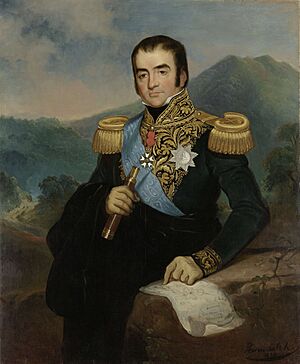
For a short time, from 1806 to 1815, the Netherlands was part of France. So, Bali had contact with a French-Dutch government. Napoleon sent a new Governor-General, Willem Daendels, to strengthen the East Indies against British attacks. An agreement was signed in 1808 between this new government and the Balinese king of Badung. This agreement was meant to provide workers and soldiers for defense. However, Java was taken by the British in 1811, so the agreement was never fully put into action.
During the British control of the East Indies (1811-1816), the British tried to make deals with the Balinese kings. But the British decision to end certain practices angered the Rajas of Buleleng and Karangasem. They sent a military group against Blambangan in 1814. In May, the British sent their own force to Bali to get promises of cooperation. The British leader, Stamford Raffles, visited the island himself in 1815.
The British gave the East Indies back to the Netherlands in 1816. After this, the Dutch worked to strengthen their control over their colonies. This led to a much stronger Dutch presence in Indonesia and Bali. Raffles, still looking for an island to colonize, eventually chose Singapore.
The Dutch sent a special official to sign agreements with the Balinese kings. The kings did not accept these agreements, but the Dutch considered them valid. Meanwhile, some European traders, like the Danish merchant Mads Lange, became important go-betweens for Bali and Europe.
-
The factory of Mads Lange in Kuta around 1845.
-
Balinese Raja, in Thomas Stamford Raffles's The History of Java, 1817
Modern History: Dutch Control and Independence (1846–Present)
The Dutch colonial empire grew across Indonesia in the 1800s, becoming the Dutch East Indies. In Bali, the Dutch used reasons like stopping illegal trade, weapon smuggling, and ship looting to take control of the Balinese kingdoms.
Dutch Take Control of Northern Bali (1846–1849)
The Dutch launched three military attacks between 1846 and 1849. The first two were successfully fought off by a Balinese leader named Jelantik. However, the kingdoms of Buleleng and Bangli were constantly fighting. In 1849, Bangli helped the Dutch in their fight against Buleleng. This allowed the Dutch to take control of the northern Balinese kingdoms of Buleleng and Jembrana.
Colonial Government in Bali
After taking control, the Dutch set up a colonial government in northern Bali. They appointed a member of the royal family as a local leader, called a regent. They also assigned a Dutch Controller to work with him.
The first Dutch Controller, Heer van Bloemen Waanders, arrived in Singaraja in 1855. He introduced many changes, such as vaccination, banning certain traditional practices, and improving irrigation for farming. He also encouraged coffee farming, built roads, bridges, and port facilities to improve trade. The Dutch also greatly increased taxes on people and trade, especially on certain goods. By the mid-1870s, many ships visited Buleleng each year. Attempts to introduce Christianity were not successful.
There were several uprisings against Dutch rule. In 1858, a Balinese noble named Njoman Gempol led a rebellion. The Dutch sent a military force and put down the rebellion, sending Njoman Gempol away to Java. Another rebellion was led by Ida Mahe Rai in 1868. The Dutch sent a large military force and eventually won, but they lost many soldiers.
Expanding Dutch Control (1894–1908)
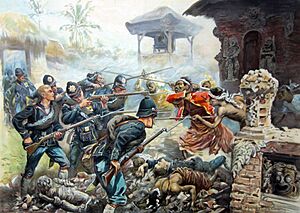
In the late 1890s, the Dutch used conflicts between Balinese kingdoms in the south to increase their power. A war between Balinese rulers from 1884 to 1894 gave the Dutch another reason to step in. In 1894, the Dutch defeated the Balinese ruler of Lombok. This added both Lombok and Karangasem to their controlled areas.
A few years later, the Dutch launched large attacks in the Sanur region in 1906. They used the reason of stopping the looting of shipwrecks. This led to the end of the royal family of Badung and about 1000 deaths. In 1908, a similar event happened in Klungkung, ending the Majapahit dynasty that had ruled the island. This gave the Dutch complete control over Bali. After this, Dutch governors managed the island, but they generally allowed local control over religion and culture to continue.
However, the Dutch military actions were widely reported by the Western press. These reports highlighted the violent and bloody conquest of southern Bali. This damaged the Netherlands' image as a kind colonial power. To improve their image, the Netherlands announced a new "Ethical policy." As a result, the Dutch in Bali started to study and protect Balinese culture. They tried to preserve Bali's culture and make it a "living museum" of classical culture. In 1914, Bali was opened to tourism.
In the 1930s, many famous artists and scientists visited Bali. They created an image of Bali as a peaceful and beautiful place. This is when Western tourism first started to grow on the island.
World War II and Indonesian Independence
Imperial Japan took control of Bali during World War II. They said their goal was to free Asian countries from Western rule. Leaders like Sukarno, who would later become Indonesia's first president, were supported by the Japanese. However, the Japanese rule was harsh, and many people wanted independence.
After Japan surrendered in August 1945, the Balinese took over Japanese weapons. The next month, British and Indian forces liberated Bali. Once the Japanese soldiers left, the island was given back to the Dutch the following year.
The Dutch returned and tried to bring back their old colonial government. A Balinese leader, Colonel I Gusti Ngurah Rai, formed a Balinese "freedom army." In November 1946, in the Battle of Margarana, his battalion was completely defeated by heavily armed Dutch troops. This ended the main Balinese military resistance. However, other leaders continued to fight the Dutch until 1948.
In 1946, the Dutch made Bali one of 13 areas in the new State of East Indonesia. This was a rival state to the Republic of Indonesia, which was led by Sukarno and Hatta. The Balinese resistance was so strong that the Dutch set up many prison camps. Finally, Bali became part of the United States of Indonesia when the Netherlands recognized Indonesia's independence in December 1949. The first governor of Bali, Anak Agung Bagus Suteja, was appointed by President Sukarno in 1958, when Bali became a province.
Bali After Independence
The 1963 eruption of Mount Agung caused great damage and forced many Balinese people to move to other parts of Indonesia. In the 1950s and early 1960s, there were growing social differences in Bali. Some people supported the traditional caste system, while others rejected these old ways. This led to tensions between different political groups.
In 1965, there was an attempted coup in Jakarta. Forces led by General Suharto put it down. The army then started a violent campaign against people they blamed for the coup. Many people were killed across Indonesia, including an estimated 80,000 in Bali. This was about 5% of the island's population. After these events, Suharto became president. His new government, called the "New Order," re-established ties with Western countries.
Bali's image as a "paradise" was brought back in a modern way. The huge growth in tourism has greatly improved the lives of many Balinese people. It has also brought a lot of money to the country. Tourism has helped Bali keep its unique identity and culture strong.
By 1999, there were about 30,000 hotel rooms for tourists. By 2004, the island had over 1 million visitors each year. This growth led to too much development and environmental problems like polluted beaches and water shortages. Political problems also affected the island. In 2002, a bombing in the tourist area of Kuta killed 202 people, mostly foreigners. Another attack happened in 2005. These events severely hurt tourism and caused economic hardship for the island.
However, tourism has strongly recovered. By the end of 2008, Bali had more than 2 million visitors. The challenge for Bali now is to manage tourism while keeping the island a good place to live, especially with issues like overdevelopment and traffic jams.
-
Sukarno, President of Indonesia (1945-1968), had a Balinese mother.


